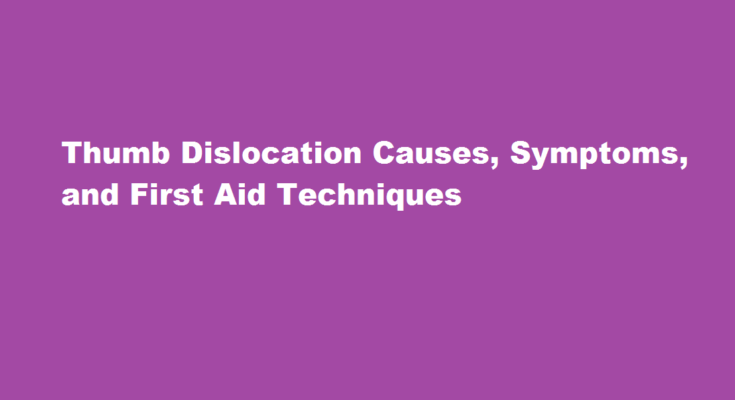Introduction
Thumb dislocation is a painful injury that occurs when the bones of the thumb joint are forced out of their normal position. It can result from accidents, sports-related activities, or sudden impacts. This article aims to provide useful information on thumb dislocation, including its causes, symptoms, and essential first aid techniques.
Causes of Thumb Dislocation
Thumb dislocation commonly occurs due to sudden impact or excessive force applied to the thumb joint. The primary causes include falls, direct blows to the thumb, sports injuries, and accidents. High-impact activities such as basketball, football, and skiing pose a higher risk. Additionally, hyperextension or twisting motions of the thumb can also lead to dislocation. It is essential to recognize the potential causes to reduce the risk of such injuries and take necessary precautions during physical activities.
Symptoms of Thumb Dislocation
Recognizing the symptoms of thumb dislocation is crucial for prompt medical attention and effective treatment. Common signs include intense pain, swelling, bruising, deformity or misalignment of the thumb joint, limited range of motion, and difficulty gripping or grasping objects. In severe cases, numbness or tingling sensation in the thumb or hand may be present. It is important to distinguish between a dislocation and a fracture, as the treatment methods may differ. Seeking professional medical evaluation is recommended to accurately diagnose and treat a thumb dislocation.
First Aid Techniques for Thumb Dislocation
When encountering a thumb dislocation, it is important to provide immediate first aid to alleviate pain and prevent further damage. Follow these steps
- Assess the situation Before attempting any treatment, assess the severity of the dislocation. If the thumb appears deformed, swollen, or immobile, or if there is severe pain, it is advisable to seek medical attention promptly.
- Stay calm and reassure the injured person Encourage the individual to remain calm and reassure them that help is on the way. Reducing anxiety can help minimize pain and aid in the treatment process.
- Immobilize the thumb To prevent further injury, immobilize the thumb by creating a splint. Gently straighten the thumb, aligning it with the rest of the hand. Use a stiff material, such as a folded newspaper or a ruler, to provide support. Secure the splint by wrapping it around the thumb with a bandage or medical tape. Be cautious not to wrap it too tightly, as this may cut off circulation.
- Apply cold compress To reduce pain and swelling, apply a cold compress or ice pack wrapped in a thin cloth to the affected area. Keep the ice on for 15-20 minutes, then remove it for the same duration. Repeat this process several times within the first 24 hours after the injury.
- Elevate the hand Elevating the hand above the heart level can help minimize swelling. Prop the injured hand on a pillow or cushion to promote fluid drainage and reduce inflammation.
- Provide pain relief Over-the-counter pain medications such as acetaminophen or ibuprofen can be taken to alleviate pain and reduce inflammation. Always follow the recommended dosage guidelines and consult a healthcare professional if necessary.
- Seek medical attention Even if the dislocation appears minor, it is crucial to seek medical evaluation. A healthcare professional will conduct a thorough examination, potentially perform an X-ray, and determine the appropriate treatment plan.
FREQUENTLY ASKED QUESTIONS
Is a dislocated finger painful?
A dislocated finger is usually obvious. The finger appears crooked, swollen and is very painful. It may be bent upward or at strange angles.
Which finger is easiest to dislocate?
Dislocation of the metacarpophalangeal joint is a rare injury. The index finger is most frequently involved, followed by the thumb; the little finger is very seldom affected. The Complex dislocation of the little finger metacarpophalangeal joint is extremely rare.
Conclusion
Thumb dislocation is a painful injury that requires immediate attention and appropriate treatment. By recognizing the causes, symptoms, and implementing proper first aid techniques, the initial pain and potential complications can be minimized. Seeking professional medical evaluation is essential to ensure a proper recovery and prevent long-term complications.
Read Also : Practical Techniques to Dislodge Food Stuck in the Esophagus



